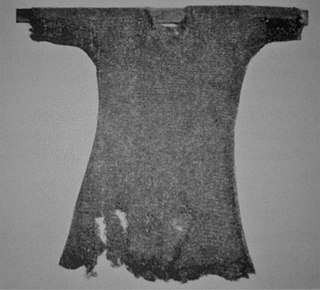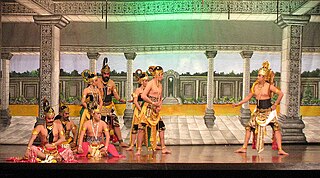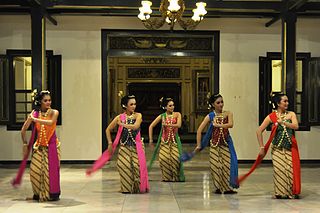
Gamelan is the traditional ensemble music of the Javanese, Sundanese, and Balinese peoples of Indonesia, made up predominantly of percussive instruments. The most common instruments used are metallophones played by mallets and a set of hand-played drums called kendhang/Kendang, which register the beat. The kemanak and gangsa are commonly used gamelan instruments in Bali. Other instruments include xylophones, bamboo flutes, a bowed instrument called a rebab, a zither-like instrument siter and vocalists named sindhen (Female) or gerong (Male).

Batik is a technique of wax-resist dyeing applied to the whole cloth. This technique originated from the island of Java, Indonesia. Batik is made either by drawing dots and lines of the resist with a spouted tool called a canting, or by printing the resist with a copper stamp called a cap. The applied wax resists dyes and therefore allows the artisan to colour selectively by soaking the cloth in one colour, removing the wax with boiling water, and repeating if multiple colours are desired.

The kris or keris in the Indonesian and Malay languages, is an asymmetrical dagger with distinctive blade-patterning achieved through alternating laminations of iron and nickelous iron (pamor). Of Javanese origin, the kris is famous for its distinctive wavy blade, although many have straight blades as well, and is one of the weapons commonly used in the pencak silat martial art native to Indonesia, Malaysia, & Brunei.

The Sultanate of Mataram was the last major independent Javanese kingdom on the island of Java before it was colonised by the Dutch. It was the dominant political force radiating from the interior of Central Java from the late 16th century until the beginning of the 18th century.

Topeng is a dramatic form of Indonesian dance in which one or more mask-wearing, ornately costumed performers interpret traditional narratives concerning fabled kings, heroes and myths, accompanied by gamelan or other traditional music instruments.

Salatiga is a city in Central Java province, Indonesia. It covers an area of 56.781 km2 and had a population of 192,322 at the 2020 Census. Located between the cities of Semarang and Surakarta, and administratively an independent city enclaved within Semarang Regency, it sits at the foot of Mount Merbabu (3,142 m) and Mount Telomoyo, and has a relatively cool climate due to its elevated position. Salatiga is a part of the Semarang metropolitan area.

Hamengkubuwono I, born Raden Mas Sujana, was the first sultan of Yogyakarta, reigning between 1755 and 1792.

Wayang wong, also known as wayang orang, is a type of classical Javanese and Balinese dance theatrical performance with themes taken from episodes of the Ramayāna or Mahabharāta. Performances are stylised, reflecting Javanese court culture:
Wayang wong dance drama in the central Javanese Kraton of Yogyakarta represents the epitome of Javanese aesthetic unity. It is total theatre involving dance, drama, music, visual arts, language, and literature. A highly cultured sense of formality permeates every aspect of its presentation.

Javanese dance is the dances and art forms that were created and influenced by Javanese culture in Indonesia. Javanese dance movement is controlled, deliberate and refined. Javanese art often displays a finesse, and at the same time a serene composure which is elevated far above everything mundane. Javanese dance is usually associated with courtly, refined and sophisticated culture of the Javanese kratons, such as the bedhaya and srimpi dance. However, in a wider sense, Javanese dance also includes the dances of Javanese commoners and villagers such as ronggeng, tayub, reog, and jaran kepang.

Kuda Lumping is a traditional Javanese dance originated from Ponorogo, East Java, Indonesia depicting a group of horsemen. Dancers "ride" horses made from woven bamboo and decorated with colorful paints and cloth. Generally, the dance portrays troops riding horses, but another type of Kuda Lumping performance also incorporates trances and magic tricks. When the "possessed" dancer is performing the dance in trance conditions, he can display unusual abilities, such as eating glass and resistance to the effects of whipping or hot coals.

Surakarta Sunanate was a Javanese monarchy centred in the city of Surakarta, in the province of Central Java, Indonesia.
Atilah Soeryadjaya is an Indonesian theatre producer, director, dancer, businesswoman, and socialite whose career spanned since 2010. She is the Javanese noblewoman through her grandfather, a Surakarta-based Javanese king, Mangkunegara VII. She is married to the business tycoon, Edward Soeryadjaya, son of the founder of Astra International, William Soeryadjaya.

It is quite difficult to define Indonesian art, since the country is immensely diverse. The sprawling archipelago nation consists of 17.000 islands. Around 922 of those permanently inhabited, by over 1,300 ethnic groups, which speak more than 700 living languages.

The makuṭa, variously known in several languages as makuta, mahkota, magaik, mokot, mongkut or chada, is a type of headdress used as crowns in the Southeast Asian monarchies of today's Cambodia and Thailand, and historically in Java and Bali (Indonesia), Malaysia, Laos and Myanmar. They are also used in classical court dances in Cambodia, Indonesia, Malaysia and Thailand; such as khol, khon, the various forms of lakhon, as well as wayang wong dance drama. They feature a tall pointed shape, are made of gold or a substitute, and are usually decorated with gemstones. As a symbol of kingship, they are featured in the royal regalia of both Cambodia and Thailand.

The Baju Rantai is a type of armor from Nusantara archipelago.

Indonesian theatre is a type of art in the form of drama performances that are staged on a stage, with a distinct Indonesian nuance or background. In general, theatre is an art that emphasizes the performing arts that are displayed in front of a large crowd. In other words, theater is a form of visualisation of a drama that is staged on the stage and watched by the audience. Indonesian theatre includes the performing arts of traditional theater and modern theatre located in the territory of Indonesia. Some examples of Indonesian theater are Arja, Wayang, Wayang wong, Lenong, Ludruk, Janger and others. Theatre in Indonesia can also be referred to as regional or ethnic theatre, because it originates and develops from 1,300 ethnic cultures in Indonesia.

Gambyong is a traditional Javanese dance originating from Surakarta, Central Java. This dance has existed since ancient times and began to be displayed at the Mangkunegaran Palace in the era of 1916 to 1944. Gambyong became famous for his smooth and graceful dance moves that amazed the audience who saw him.

Lengger dance is a traditional Javanese dance originating from Banyumas, Central Java, Indonesia. This dance is played in pairs, between a man and a woman. Lengger dance is one of the sacred dances in Java.

Lenger lanang is a traditional Javanese dance originating from Banyumas, Central Java, Indonesia. This dance has existed for hundreds of years, lengger lanang is not just an ordinary dance, but a tradition of worshiping the Goddess of Fertility to celebrate harvests or village clean ceremonies that have been passed down from generation to generation. Lengger lanang dance is a form of cross-gender culture in Indonesia. This dance is categorized as cross-gender because the performer is a man who looks like a woman.


























